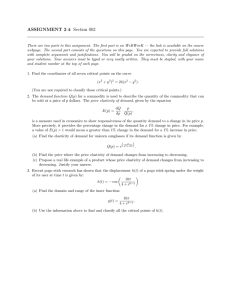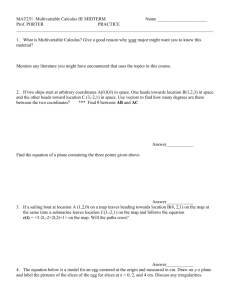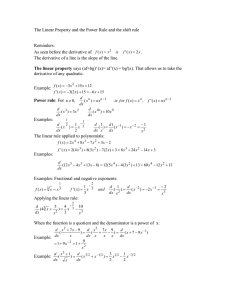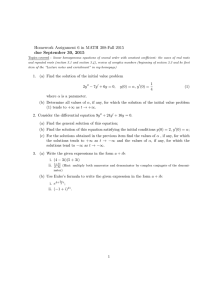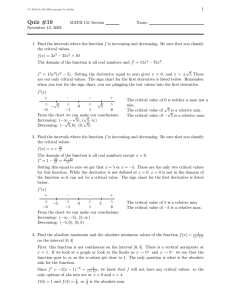Mathematics 110-002 Assignment 2.4 Questions:
advertisement
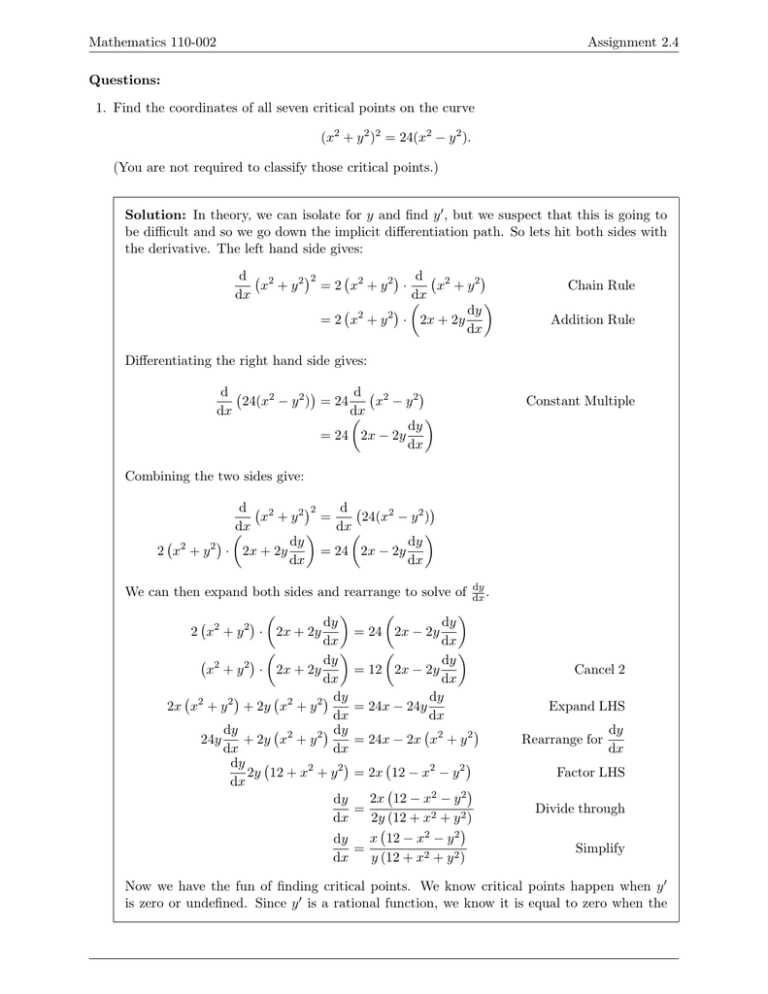
Mathematics 110-002 Assignment 2.4 Questions: 1. Find the coordinates of all seven critical points on the curve (x2 + y 2 )2 = 24(x2 − y 2 ). (You are not required to classify those critical points.) Solution: In theory, we can isolate for y and find y 0 , but we suspect that this is going to be difficult and so we go down the implicit differentiation path. So lets hit both sides with the derivative. The left hand side gives: 2 d d x2 + y 2 = 2 x2 + y 2 · x2 + y 2 dx dx dy 2 2 = 2 x + y · 2x + 2y dx Chain Rule Addition Rule Differentiating the right hand side gives: d d 24(x2 − y 2 ) = 24 x2 − y 2 dx dx dy = 24 2x − 2y dx Constant Multiple Combining the two sides give: 2 d d x2 + y 2 = 24(x2 − y 2 ) dx dx dy dy 2 2 2 x + y · 2x + 2y = 24 2x − 2y dx dx dy We can then expand both sides and rearrange to solve of dx . dy dy 2 2 = 24 2x − 2y 2 x + y · 2x + 2y dx dx dy dy 2 2 x + y · 2x + 2y = 12 2x − 2y dx dx dy dy 2x x2 + y 2 + 2y x2 + y 2 = 24x − 24y dx dx dy dy 24y + 2y x2 + y 2 = 24x − 2x x2 + y 2 dx dx dy 2 2y 12 + x + y 2 = 2x 12 − x2 − y 2 dx 2x 12 − x2 − y 2 dy = dx 2y (12 + x2 + y 2 ) x 12 − x2 − y 2 dy = dx y (12 + x2 + y 2 ) Cancel 2 Expand LHS Rearrange for dy dx Factor LHS Divide through Simplify Now we have the fun of finding critical points. We know critical points happen when y 0 is zero or undefined. Since y 0 is a rational function, we know it is equal to zero when the Mathematics 110-002 Assignment 2.4 numerator is zero and undefined when the denominator is zero. In the first case, we must have x(12 − x2 − y 2 ) = 0. This occurs when x = 0 or 12 − x2 − y 2 = 0. The derivative is undefined when the denominator is zero. That is, y(12 + x2 + y 2 ) = 0, which means y = 0 or 12 + x2 + y 2 = 0. However, in that second case, we have a sum of three positive number, which mean it will never be zero regardless of the choice we make for x and y. Now that we have the conditions, we want to see when they intersect the curve (since a critical point also has to be a point on the curve). So all that is left to do is substitute the three remaining cases into the curve equation: 1. The first (easiest) case is when x = 0. Substituting it into the curve equation gives: (x2 + y 2 )2 = 24(x2 − y 2 ) (02 + y 2 )2 = 24(02 − y 2 ) (y 2 )2 = −24(y 2 ) y 4 = −24y 2 y 4 + 24y 2 = 0 y 2 (y 2 + 24) = 0 So we must have y = 0 or the other case y 2 + 24 = 0 which will give no solutions. This gives us one critical point (0, 0). 2. The second (easiest) case is when y = 0.Substituting it into the curve equation gives: (x2 + y 2 )2 = 24(x2 − y 2 ) (x2 + 02 )2 = 24(x2 − 02 ) (x2 )2 = 24(x2 ) x4 = 24x2 x4 − 24x2 = 0 x2 (x2 − 24) = 0 √ So have x = 0 or x = ± 24. This gives us three critical points, (0, 0), √ we must √ ( 24, 0), (− 24, 0). But unfortunately, we have found one of them already. So this really just counts for two critical points. 3. Finally, we tackle the case where 12 − x2 − y 2 = 0. By rearranging, I get 12 − x2 = y 2 , Mathematics 110-002 Assignment 2.4 which I will conveniently substitute into the original curve to get: (x2 + y 2 )2 = 24(x2 − y 2 ) (x2 + (12 − x2 ))2 = 24(x2 − (12 − x2 )) (x2 + 12 − x2 )2 = 24(x2 − 12 + x2 )) (12)2 = 24(2x2 − 12) 12 = 2(2x2 − 12) 6 = 2x2 − 12 18 = 2x2 9 = x2 x = ±3. So that means we must have x = −3, 3. Now we find the each y value for each by substituting it into the easier equation. y 2 = 12 − (−3)2 y 2 = 12 − 9 √ y=± 3 Now looking at the x = 3 case, we get: y 2 = 12 − (3)2 y 2 = 12 − 9 √ y=± 3 √ √ √ √ So that means we get the critical points of (−3, − 3), (−3, 3), (3, − 3), (3, 3). This counts for four critical points. Combining the above cases, we get one critical point from the first case, two from the next and four from the last. This gave the seven critical points of the curve. 2. The demand function Q(p) for a commodity is used to describe the quantity of the commodity that can be sold at a price of p dollars. The price elasticity of demand, given by the equation E(p) = dQ p · , dp Q(p) is a measure used in economics to show responsiveness of the quantity demand to a change in its price p. More precisely, it provides the percentage change in the demand for a 1% change in price. For example, a value of E(p) > 1 would mean a greater than 1% increase in the demand for a 1% increase in price. (a) Find the elasticity of demand for unicorn sunglasses if its demand function is given by Q(p) = e p p2 +100 . Mathematics 110-002 Assignment 2.4 Solution: To find E(p), we need to find the derivative of the demand function Q(p). So we start by hitting it with a chain rule: Let: u(p) = p2 p + 100 Q(u) = eu Then we have: Q0 (u) = eu To get u0 (p), use the quotient rule: m(p) = p n(p) = p2 + 100 m0 (p) = 1 n0 (p) = 2p So we have: u0 (p) = p2 + 100 − 2p2 (p2 + 100)2 So we have the overall derivative as: 0 Q (p) = −p2 + 100 (p2 + 100)2 ·e p p2 +100 Combining this knowledge, we get: E(p) = = dQ p · dp Q(p) −p2 + 100 (p2 + 100) 2 p p2 +100 ·e = = p · e p p2 +100 p p2 +100 −p2 + 100 · e = (p2 + 100)2 e −p2 + 100 · p p p2 +100 ·p (p2 + 100)2 −p3 + 100p (p2 + 100)2 (b) Find the price where the price elasticity of demand changes from increasing to decreasing. Solution: Increasing and decreasing functions means we have to look at derivatives. Mathematics 110-002 Assignment 2.4 So lets find the derivative of E(p). Let u = −p3 + 100p u0 = −3p2 + 100 v = (p2 + 100)2 v 0 = 4p(p2 + 100) Combining the above, we get: E 0 (p) = = = = = = (p2 + 100)2 · (−3p2 + 100) − (−p3 + 100p) · (4p(p2 + 100)) (p2 + 100)4 (p2 + 100)2 · (−3p2 + 100) − (−p3 + 100p) · (4p(p2 + 100)) (p2 + 100)4 (p2 + 100) · (p2 + 100)(−3p2 + 100) − 4p(−p3 + 100p) (p2 + 100)4 (p2 + 100)(−3p2 + 100) − 4p(−p3 + 100p) (p2 + 100)3 4 2 −3p − 200p + 10000 + 4p4 − 400p2 (p2 + 100)3 p4 − 600p2 + 10000 (p2 + 100)3 To find there the derivative is undefined, we see where the denominator is zero. But p2 will never be negative and hence p2 +100 will always be positive and so the denominator is never zero. This leaves the case where the numerator is zero (and hence a zero derivative). This means we are solving for when p4 − 600p2 + 10000 = 0. Solving fourth degree polynomials are a mess usually, but fortunately for us, this one turns out pretty nice because it only contains even powers. Start by letting u = p2 , then: 0 = p4 − 600p2 + 10000 = (p2 )2 − 600p2 + 10000 = u2 − 600u + 10000 at this point, we can use our quadratic equation: p −(−600) ± (−600)2 − 4(1)(10000) u= 2 √ 600 ± 360000 − 40000 = √ 2 600 ± 320000 = 2 √ 600 ± 2 · 160000 = √2 √ 600 ± 2 · 160000 = 2√ 600 ± 400 2 = 2 √ = 100 · (3 ± 2 2) Mathematics 110-002 Assignment 2.4 This gives us two solutions for u. But since u = p2 , we need to square root it again to get the four solutions: q √ P = ± 100 · (3 ± 2 2) Listing out the four solutions: q √ p = 10 · 3 + 2 2 q √ p = −10 · 3 + 2 2 q √ p = 10 · 3 − 2 2 q √ p = −10 · 3 − 2 2 Now this is where it gets a little tricky. We are dealing with price, so that means we should only consider p > 0 since a negative price is somewhere strange. So that means we have to worry about the first and third listed critical points. Using the table method, we get: Interval p √ (0, 10 3 −p 2 2) p √ √ (10 3 −p 2 2, 10 3 + 2 2) √ (10 3 + 2 2, ∞) E 0 (p) Inc/Dec positive negative positive Increasing Decreasing Increasing p √ So that means the price goes from increasing to decreasing at the price p = 10 3 − 2 2. Solution: As an aside, the square root inside a square root is pretty ugly, we can actually simplify it a little bit as follows, suppose we write q √ √ √ 3−2 2= A− B √ √ 2 √ 3−2 2= A− B √ √ 3 − 2 2 = A + B − 2 AB So that means we have two equations: A+B =3 AB = 2 which means A = 2 and B = 1 (since the result has to be positive). Hence we have p √ √ 3 − 2 = 2 − 1. In terms of p this means our optimal price is: √ √ p = 10( 2 − 1) = 10 2 − 10 This process is called denesting radicals. Not critical to the problem, but it does make the solution nicer :D. (c) Propose a real life example of a product whose price elasticity of demand changes from Mathematics 110-002 Assignment 2.4 increasing to decreasing. Justify your answer. Solution: Preamble: This is quite an interesting problem. Despite the price elasticity of demand being an economic quantity, most economic questions (in first year) deal with the value of E(p) as opposed to the trends in E(p). In this case, we want an increase/decrease in E(p), but we have the freedom to choose the actual values. Actual Solution: I want to pick a product such that the price elasticity goes from zero to one then goes negative and hence satisfying the increasing and decreasing condition. So possibly the price elasticity might look something like: Such a product might be a luxury good. Examples are branded handbags with French or Italian names that this instructor cannot pronounce (I think they are French or Italian names), or headphones by a certain Doctor. The decrease in elasticity is expected due to the increase in price. A product that is overly priced will result in a significant decrease in the demand, hence the eventual negative elasticity. The challenge seems to be explaining why it is increasing to begin with. A positive price elasticity means an increase in price will give a increase in demand. The seems to agree with the notion of a luxury good. Headphones priced by the same doctor sold at $20 will not be as in demand as the same headphones sold at $200 (especially with the number of fakes and imitations floating around). This will explain the increasing/decreasing trends we are looking for. 3. Recent pogo stick research has shown that the displacement h(t) of a pogo stick spring under the weight of its user at time t is given by: 10π h(t) = − cos 4 + e6−t (a) Find the domain and range of the inner function: g(t) = 10π . 4 + e6−t Solution: Our old friend domain and range are making a comeback. Recall that the domain is the values of t we can throw into the function. The other way to look at it is to see what values of t will break the function and then take those out of the domain. Since the only t appears in the denominator, we know the values of t that make the denominator zero will not be in the domain. We know the regardless of what t we choose, e6−t will always be positive and hence can never equal the −4 we need to make the denominator zero. Hence the domain is all the real numbers (because no numbers break the function). To get the range is a little more difficult. We make use of the fact that the exponential function ex gets bigger as x gets bigger and ex gets smaller as x gets smaller. First, Mathematics 110-002 Assignment 2.4 lets suppose t gets really negative, then 6 − t is really positive and hence e6−t is really big. So that means the denominator is really big and the overall result is a very small output (but positive nonetheless). Similarly, if t gets really positive, 6 − t is really negative and hence e6−t is really small. So that means the denominator is really close 10π 5π to 4 (but bigger than 4). This means this overall output will be very close to 4 = 2 . 5π This means the range of our function is 0, 2 . (b) Use the information above to find and classify all the critical points of h(t). Solution: Time to corner those critical points again. We start with the classic first derivative opening with the chain rule variation: 10π 4 + e6−t h(u) = − cos(u) u(t) = which gives: h0 (u) = sin(u) This means we have to deal with the threat in the form of: 10π u(t) = 4 + e6−t −1 = 10π · 4 + e6−t which can be easily countered using the chain rule −2 u0 (t) = 10π · (−1) · −e6−t · 4 + e6−t = 10πe6−t (4 + e6−t )2 By chaining our chain rules, we get the overall derivative 10π 10πe6−t · sin h0 (t) = 4 + e6−t (4 + e6−t )2 10π 6−t 10πe sin 4+e6−t = (4 + e6−t )2 Having put ourselves in such a strong position, we head into the technical middle game by ripping the function to bits. For t to be critical point, the derivative has to be zero or undefined. Making use of our pre-game preparations in the previous part, we can see that the denominator is never zero since 4 + e6−t is never zero. So that means the critical points can hide in the numerator. We are multiplying a whole bunch of stuff together, so one of them has to be zero if the whole thing is zero. Going through bit by bit: We see 10π is a non-zero constant and e6−t will always be positive. That means the critical points can only hide in that sine functions (See what I mean by ripping it to bits). So the only thing that stands in our way is solving when: 10π =0 sin 4 + e6−t Mathematics 110-002 Assignment 2.4 The standard theory tells us that sin(x) is zero when x = 0, ±π, ±2π, ±3π, . . .. So our strategy is to find the key points where the function inside the sine is equal to those values. In theory, there are infinitely many solutions we have to check. However, we have done the pre-game work and making use of the range we’ve prepared in the previous part, we see that only π and 2π fall into the possible outputs of the inner function, so we only have to worry about two cases: 10π =π 4 + e6−t 10 =1 4 + e6−t 4 + e6−t = 10 e6−t = 6 6 − t = ln(6) t = 6 − ln(6). In the other case: 10π = 2π 4 + e6−t 5 =1 4 + e6−t 4 + e6−t = 5 e6−t = 1 6 − t = ln(1) 6−t=0 t = 6. So we now we can approach our endgame focusing on the two critical points t = 6−ln(6) and t = 6. Partitioning the domain by our critical points and then checking each one by picking a point in each interval, we get: Interval (−∞, 6 − ln(6)) (6 − ln(6), 6) (6, ∞) h0 (t) positive negative positive Inc/Dec Increasing Decreasing Increasing Those critical points have nowhere to hide and we close in for the kill with identify t = 6 − ln(6) as a local maximum and t = 6 as a local minimum. All critical points classified. Checkmate, Math!
